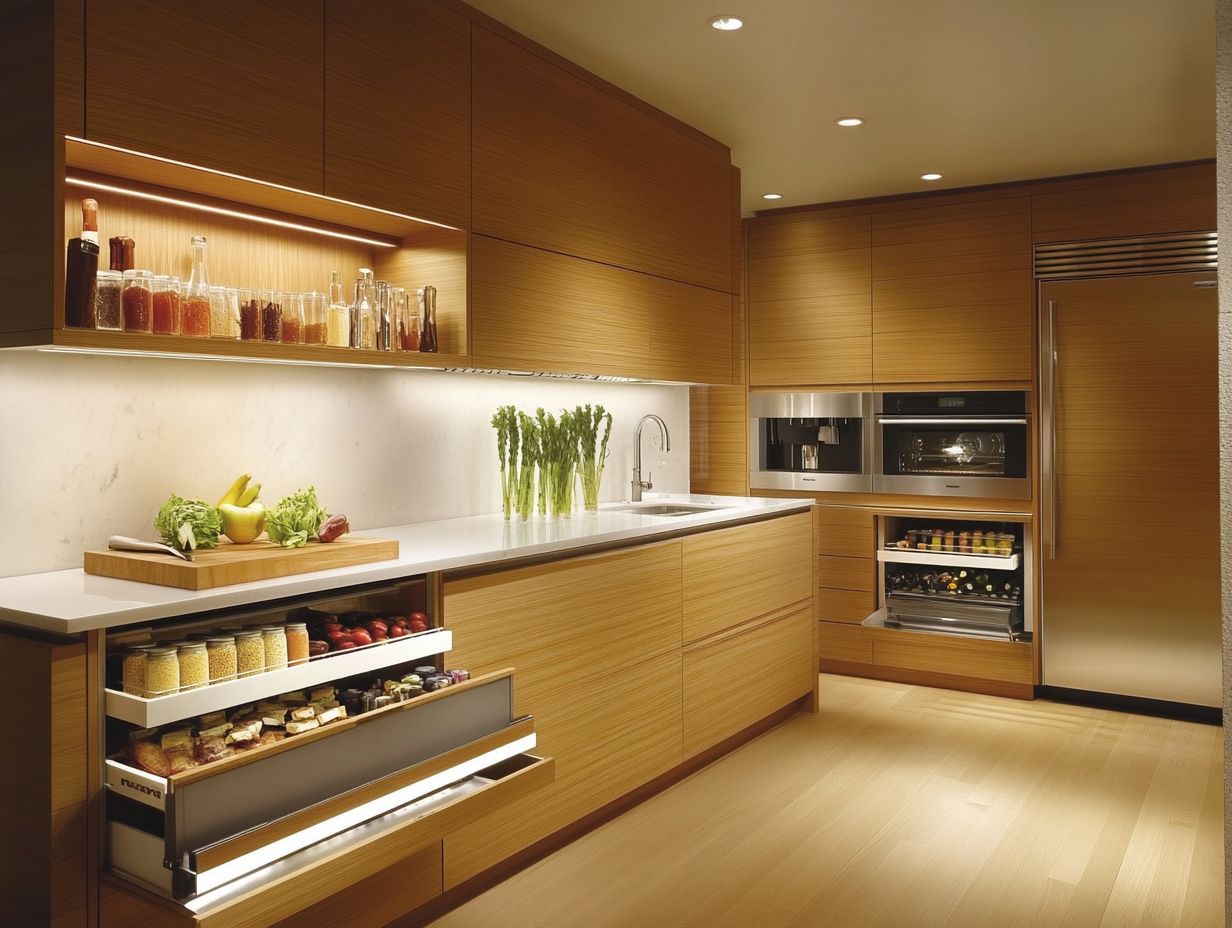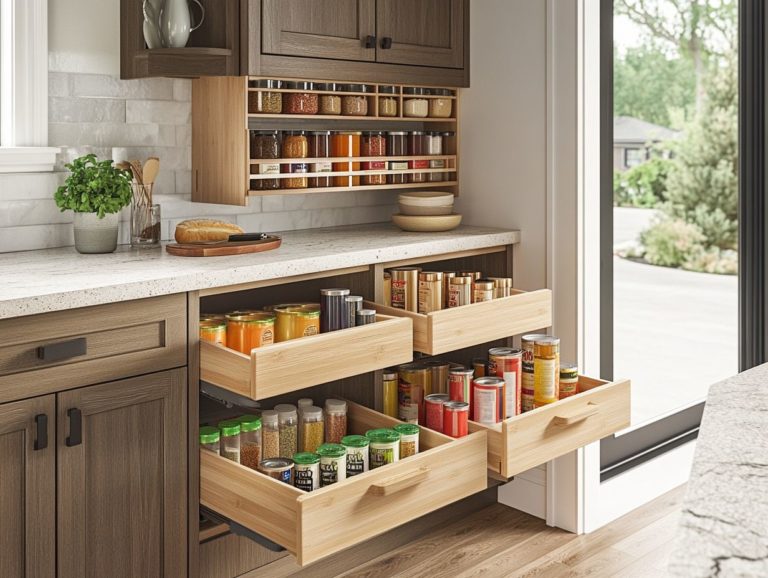The Impact of Cabinet Design on Kitchen Workflow
A thoughtfully designed kitchen transcends mere aesthetics; it fundamentally enhances your cooking efficiency and organizational flow.
This article explores how cabinet design optimizes your kitchen workflow. From ergonomic considerations and accessibility to maximizing storage and space, every detail contributes to crafting a functional culinary environment.
You’ll learn how to customize your kitchen to suit your individual cooking habits while ensuring a stylish and cohesive appearance. Uncover the secrets to achieving a harmonious kitchen layout that truly works for you!
Contents
- Key Takeaways:
- The Importance of Kitchen Workflow
- Factors to Consider in Cabinet Design
- Maximizing Space and Efficiency
- Designing for Your Specific Needs
- Maintaining a Functional and Aesthetic Balance
- Frequently Asked Questions
- What is the impact of cabinet design on kitchen workflow?
- How can cabinet design affect kitchen workflow?
- What are some important factors to consider when designing kitchen cabinets?
- How can a well-designed cabinet layout improve kitchen workflow?
- What are some common mistakes to avoid when designing kitchen cabinets?
- Are there any specific cabinet designs that are recommended for improving kitchen workflow?
Key Takeaways:

Proper cabinet design can greatly improve the efficiency and functionality of a kitchen workflow. Factors such as ergonomics, storage, and customization should be considered to enhance workflow. Balancing functionality and aesthetics through materials, finishes, and cohesiveness with the rest of the kitchen is crucial in maximizing space and efficiency.
The Importance of Kitchen Workflow
Understanding kitchen workflow is key to creating a clean and efficient cooking space that meets your family’s culinary needs.
A thoughtfully designed kitchen layout can greatly enhance both functionality and aesthetics. Vital tools and appliances like the stove, refrigerator, and countertop should always be within easy reach.
By optimizing the space between your stove, sink, and refrigerator and integrating smart cabinet design, you can create an ergonomic environment that fosters culinary creativity and seamless meal preparation.
Understanding the Role of Cabinet Design
The significance of cabinet design in your kitchen is paramount, as it directly influences both functionality and aesthetics.
When you consider overall workflow, you’ll find that various cabinet types, their depth, and strategic placement can enhance task efficiency. For example, opting for deep drawers can make accessing pots and pans seamless, while positioning overhead cabinets at the right height can save you from awkward stretches.
In both traditional and modern kitchens, thoughtful design elements—like contrasting finishes or classic moldings—harmonize the space, making it practical and visually striking.
Custom cabinetry offers tailored solutions, ensuring that everything from spices to cooking utensils is organized and easily accessible, enriching your cooking experience.
Factors to Consider in Cabinet Design
When designing kitchen cabinets, several critical factors must be considered to achieve a harmonious blend of functionality and aesthetics that aligns perfectly with your preferences.
Ergonomics and Accessibility
Integrating ergonomics and accessibility into your cabinet design is essential for crafting a kitchen environment that prioritizes both comfort and efficiency.
The layout becomes increasingly vital as you engage with your kitchen space. Thoughtfully designed cabinet heights allow you to reach for ingredients and utensils effortlessly, reducing strain during meal prep.
Drawer placement is equally important; ensuring easy access to frequently used items streamlines your cooking process. By incorporating specialized storage solutions like pull-out racks and vertical dividers, you can guarantee that every item has its designated space, minimizing clutter and enhancing organization.
Focusing on these elements makes cooking not just practical but genuinely enjoyable.
Start planning your kitchen design today to enhance your cooking experience!
Storage and Organization

Maximizing storage and organization is essential for a clutter-free kitchen. A tidy space boosts both efficiency and creativity during meal prep.
By embracing creative storage solutions, you can transform your kitchen cabinets into beautifully organized spaces. Utilizing drawer organizers is a smart strategy, enabling you to sort utensils, cutting tools, and other kitchen gadgets for easy access.
Specialized storage options, such as pull-out racks for spices or dedicated compartments for pots and pans, streamline your workflow! This clever strategy puts your essential items right at your fingertips, making cooking an enjoyable and efficient experience.
When every item has its designated place, it not only enhances functionality but also elevates the overall aesthetic of your kitchen, turning it into a harmonious environment ideal for your cooking experiences.
Maximizing Space and Efficiency
Maximizing space and efficiency in your kitchen is essential for cultivating an environment that enhances your cooking experience while fostering memorable family gatherings.
It’s about striking the perfect balance between functionality and aesthetic appeal, transforming your kitchen into a harmonious blend of beauty and practicality.
Utilizing Vertical and Horizontal Space
Effectively utilizing both vertical and horizontal space is essential for crafting a well-organized kitchen that caters to your needs.
Incorporating vertical storage solutions, such as wall-mounted cabinets and shelves, allows you to maximize space significantly, particularly in kitchens with limited square footage. This strategy keeps your essential items within easy reach while liberating valuable counter space for meal preparation.
The depth and strategic placement of cabinets play a pivotal role. Deeper cabinets are perfect for storing larger pots and pans, while higher shelves can accommodate rarely used appliances or decorative elements.
By harmonizing vertical and horizontal layouts, you can achieve a functional design that enhances storage capacity while maintaining a tidy and inviting atmosphere in your kitchen.
Incorporating Multi-functional Features
Incorporating multi-functional features into your kitchen design not only elevates functionality but also enhances the versatility of the space. This evolution gives you the power to optimize your environment, creating designated zones for various kitchen appliances.
Both kitchen islands and adjustable cabinets play a crucial role in achieving this balance! They provide adaptable surfaces and storage solutions that can effortlessly accommodate everything from blenders to pots and pans.
By allowing for personalized arrangements, these designs spark creativity! An organized layout makes it easier for you to find tools and ingredients in a snap.
Ultimately, embracing flexible design transforms your cooking experience into something truly enjoyable.
Designing for Your Specific Needs
Designing a kitchen tailored to your specific needs requires thoughtful attention to customization and personalization, elevating your overall workflow to new heights.
Customization and Personalization

Customization and personalization in kitchen design are essential for creating a space that truly reflects your unique preferences and functional requirements. A well-designed kitchen should embody your style while maximizing functionality in storage and organization.
Custom cabinetry presents an exceptional opportunity! It enables you to craft unique layouts that optimize every inch of available space. When choosing materials and finishes, it’s important to weigh factors like durability, maintenance, and how different textures and colors will blend with your existing decor.
For example, natural wood can infuse warmth into the space, whereas sleek finishes may evoke a contemporary feel. The ultimate aim is to achieve a harmonious look that enhances both the beauty and practicality of your kitchen.
Considering Cooking Habits and Preferences
Understanding your cooking habits and preferences is essential for designing a kitchen that promotes efficient meal preparation. This also ensures an optimal workflow.
By recognizing how often you cook and the types of meals you prepare, you can make informed choices about cabinet design and placement. Your preferred cooking techniques play a crucial role in this process.
For instance, if you frequently bake, having easy access to baking sheets and mixing bowls can make all the difference. These items can be strategically positioned within arm’s reach.
Effective organization minimizes clutter and enhances functionality. This creates a more enjoyable cooking experience. A streamlined environment nurtures your culinary creativity, encouraging you to experiment with new recipes and cooking styles. Ultimately, it transforms your kitchen into a true culinary haven.
Maintaining a Functional and Aesthetic Balance
Striking the perfect balance between functionality and aesthetics in your kitchen design is crucial. This creates a space that is both practical and visually captivating.
Choosing Materials and Finishes
Selecting the right materials and finishes for your kitchen cabinets is essential for durability and visual appeal. Solid wood brings timeless elegance and warmth to the table.
On the other hand, laminate offers a rich variety of colors and patterns, providing a more budget-friendly option without compromising on style.
If you’re leaning towards a modern look, metal cabinets can infuse your space with an industrial vibe. This pairs beautifully with modern styles.
It’s crucial to think about how these materials will fit into your overall kitchen theme. The finishes you choose shape the visual impact and influence functionality.
For instance, a matte finish can cleverly conceal scratches. Glossy surfaces reflect light, making your space feel larger and airier. Striking the right balance between these elements ensures that your kitchen is not just stunning but also practical for everyday use.
Keeping Design Cohesive with the Rest of the Kitchen
Ensuring that your cabinet design harmonizes with the rest of your kitchen is essential. This creates a cohesive and functional space that enhances overall efficiency.
When choosing countertops, consider colors and materials that complement your cabinet finishes. They should also blend seamlessly with your appliances.
Imagine the impact of integrating stainless steel appliances with sleek cabinetry and elegant stone countertops. It can truly elevate your kitchen’s visual appeal.
Aiming for a unified design means every element works in harmony. This creates a well-organized environment that feels both inviting and practical. This transforms your kitchen into the heart of your home.
Frequently Asked Questions

What is the impact of cabinet design on kitchen workflow?
Don’t underestimate the power of good cabinet design! The impact of cabinet design on kitchen workflow is significant. It can affect efficiency, functionality, and the overall flow of your kitchen.
A well-designed cabinet layout makes tasks easier and more organized. In contrast, a poorly designed one can lead to clutter, wasted space, and difficulty accessing items.
How can cabinet design affect kitchen workflow?
Cabinet design can impact kitchen workflow in various ways. It affects ease of access to items, efficiency of movement within the kitchen, and overall organization of the space.
A well-designed cabinet layout facilitates a smooth and streamlined workflow. A poorly designed one can cause delays and frustration.
What are some important factors to consider when designing kitchen cabinets?
When designing kitchen cabinets, consider functionality, storage needs, and layout. Factors such as the size of the kitchen and the number of people using it are crucial.
The types of items that need to be stored should also be taken into account. The style and material of the cabinets should complement the overall design and aesthetic of your kitchen.
Ready to transform your kitchen? Consult a designer or explore more kitchen design tips to elevate your space!
How can a well-designed cabinet layout improve kitchen workflow?
A well-designed cabinet layout optimizes space and makes everything easily accessible. It also helps organize items, reduce clutter, and saves time in meal prep!
What are some common mistakes to avoid when designing kitchen cabinets?
Avoid mistakes like not considering the users’ needs and using low-quality materials. Also, ensure you don’t crowd the kitchen with cabinets, leaving little room to move around!
Are there any specific cabinet designs that are recommended for improving kitchen workflow?
No single cabinet design fits all, but features like pull-out shelves and deep drawers can greatly enhance functionality. Custom solutions that fit the user’s habits will make the kitchen even better!





